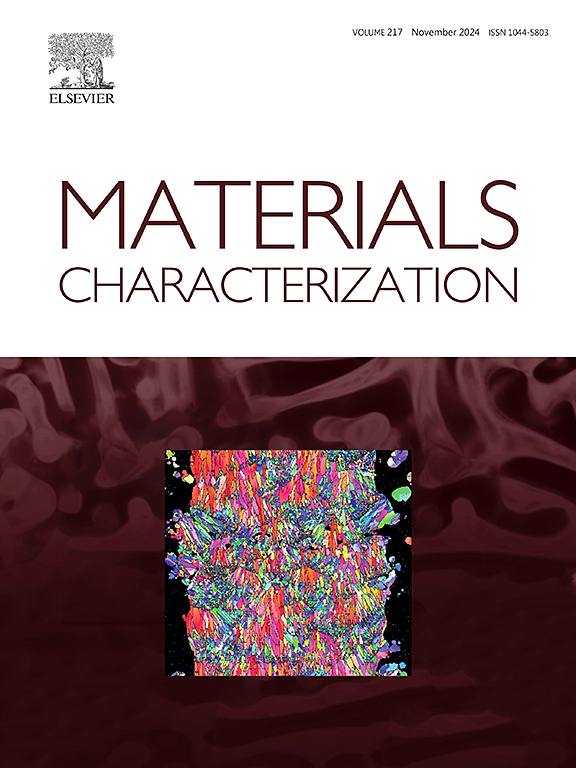TA37/TC19合金扩散键合中的热循环配位:显微组织和力学见解
IF 4.8
2区 材料科学
Q1 MATERIALS SCIENCE, CHARACTERIZATION & TESTING
引用次数: 0
摘要
为了满足下一代航空发动机的严格要求,本文将高温钛合金TA37与高强度合金TC19结合,开发了可用于离心叶轮的固体扩散连接接头。考虑到两种合金在热处理要求上的内在差异——TA37依赖于高温固溶处理,而TC19需要精确时效来精炼α/β片层——我们系统地比较了两种扩散键合方案,基本工艺为860°C, 20 MPa, 60 min。第一种策略使用了未经过额外加工的原始材料,代表了传统的工业实践。另一种则采用了统一的热处理顺序:TA37经过键合前溶液处理(1033°C/2 h, WQ)来激活纳米硅化物的形成,而TC19经过键合后溶液时效(930°C/2 h, AQ + 593°C/8 h, AC)来保持相稳定性。这种协调的方法旨在调和合金相互冲突的热历史,减轻界面退化。通过SEM、TEM、EBSD、EPMA、纳米压痕和原位拉伸测试,系统地表征了接头的界面形貌、微观结构演变和力学行为。两种情况下,TC19合金均在界面处形成约10 μm厚的扩散影响区,扩散影响区内形成双相α + β组织。最重要的是,热处理改性接头的抗拉强度达到了1076 MPa,显著高于变形材料焊接接头的959 MPa。原位拉伸实验表明,变形是通过α和β相在粘结区域的协同屈服进行的,这证实了改进的热循环促进了均匀的载荷分担并抑制了局部应变浓度。综上所述,这些结果表明,将结合前和结合后的热处理与扩散结合循环相结合可以显著提高接头的性能。本研究为异种钛合金扩散焊热处理工艺优化提供了实用框架,为先进航空发动机结构中高性能双合金部件的设计奠定了基础。本文章由计算机程序翻译,如有差异,请以英文原文为准。
Thermal cycle coordination in diffusion bonding of TA37/TC19 alloys: microstructural and mechanical insights
To meet the stringent demands of next-generation aeroengines, this paper has developed solid diffusion-bonded joints potentially used in centrifugal impellers by joining the high-temperature titanium alloy TA37 to the high-strength alloy TC19. Given the intrinsic divergence in heat-treatment requirements between two alloys—where TA37 relies on high-temperature solution treatment while TC19 demands precise aging to refine α/β lamellae—we systematically compared two diffusion bonding protocols with a basic process of 860 °C, 20 MPa for 60 min. The first strategy utilized as-received wrought base materials without additional processing, representing conventional industrial practice. In contrast, the other implemented a harmonized thermal sequence: TA37 underwent pre-bonding solution treatment (1033 °C/2 h, WQ) to activate nano-silicide formation, while TC19 received post-bonding solution-aging (930 °C/2 h, AQ + 593 °C/8 h, AC) to preserve phase stability. This coordinated approach aimed to reconcile the alloys' conflicting thermal histories and mitigate interfacial degradation. We systematically characterized the joints' interfacial morphology, microstructure evolution, and mechanical behavior using SEM, TEM, EBSD, EPMA, nanoindentation, and in-situ tensile testing. In both cases, a diffusion-affected zone approximately 10 μm thick formed at the interface, within which the TC19 alloy developed a duplex α + β structure. Crucially, the heat-treatment-modified joint achieved a tensile strength of 1076 MPa, significantly higher than the 959 MPa measured for the joint bonded using as-wrought materials. In-situ tensile experiments revealed that deformation proceeds via cooperative yielding of the α and β phases across the bonded region, confirming that the modified thermal cycle promotes uniform load sharing and suppresses localized strain concentrations. Together, these results demonstrate that integrating pre- and post-bonding heat treatments with the diffusion-bonding cycle markedly enhances joint performance. This work thus provides a practical framework for optimizing heat-treatment schedules in the diffusion bonding of dissimilar titanium alloys, laying a foundation for designing high-performance dual-alloy components in advanced aeroengine architectures.
求助全文
通过发布文献求助,成功后即可免费获取论文全文。
去求助
来源期刊

Materials Characterization
工程技术-材料科学:表征与测试
CiteScore
7.60
自引率
8.50%
发文量
746
审稿时长
36 days
期刊介绍:
Materials Characterization features original articles and state-of-the-art reviews on theoretical and practical aspects of the structure and behaviour of materials.
The Journal focuses on all characterization techniques, including all forms of microscopy (light, electron, acoustic, etc.,) and analysis (especially microanalysis and surface analytical techniques). Developments in both this wide range of techniques and their application to the quantification of the microstructure of materials are essential facets of the Journal.
The Journal provides the Materials Scientist/Engineer with up-to-date information on many types of materials with an underlying theme of explaining the behavior of materials using novel approaches. Materials covered by the journal include:
Metals & Alloys
Ceramics
Nanomaterials
Biomedical materials
Optical materials
Composites
Natural Materials.
 求助内容:
求助内容: 应助结果提醒方式:
应助结果提醒方式:


